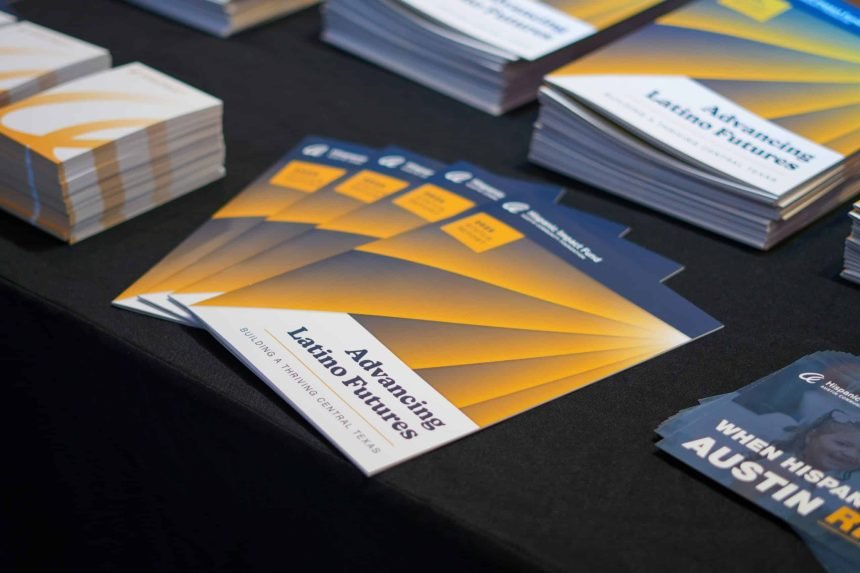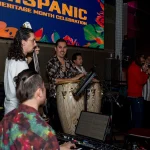A key 2025 Central Texas Hispanic status report revealed a striking contrast in the educational outcomes of students from Spanish-speaking families learning in English and Spanish. These emergent bilingual students demonstrate stronger kindergarten readiness than their English-only speaking peers, yet by the time they reach high school, they are half as likely to enroll in post-secondary programs.
The report, “Advancing Latino Futures: Building a Thriving Central Texas,” created by the Austin Community Foundation takes a deep dive into recent progress, challenges as well as opportunities for Latino families in the area. It looks at key indicators of economic mobility for Latinos in critical areas ranging from job skills and entrepreneurship to early childhood education.
“What was really wonderful to see with the emergent bilinguals at pre-K age was just how much they were truly thriving,” said Aidee Gonzalez, senior manager of community impact at the Austin Community Foundation. She attributes much of that success to pre-K serving as a “crucial bridge” for these young students. The report also found emergent bilingual students attend pre-K 4, geared toward 4-year-olds, at higher rates than other students.
Yet somewhere between this early educational success and high school graduation, a significant shift occurs. The report finds that by high school, these same students are half as likely to enroll in post-secondary education compared to students who speak only English.
Will Davies, the director of policy and research at Breakthrough Central Texas, a non-profit that provides support for first-gen college-bound students, noted that this comparison can be complicated.
“Many students who benefit from strong bilingual programs in elementary school are reclassified as ‘monitored’ or ‘non-EB’ by secondary school,” he said. “As a result, their academic progress may be undercounted or missing from secondary-level EB outcome data depending on how it’s measured.”
However, Davies acknowledges that these predominantly Spanish-speaking students face real, systemic challenges in middle and high school.
“One major issue is the limited access to high-quality bilingual education programs that affirm their bilingual and bicultural identities rather than attempting to replace or erase them,” Davies said.

Despite evidence supporting the effectiveness of dual language programs, only about 1 in 5 eligible students currently participates in them, and Texas’s overall school finance model has historically underinvested in the education of linguistically diverse students, according to Davies.
Austin ISD’s Dual Language Landscape
In Austin ISD, the landscape looks notably different. About 80% of its emergent bilingual elementary students participate in dual language, far above the state average, according to Austin ISD Directors of the Multilingual Education Department. Students who reclassify as English proficient consistently outperform their peers on state exams.
The district also offers English as a Second Language (ESL) across elementary and secondary schools, where certified ESL teachers support language development, as well as Newcomer Programs & Courses with specialized curriculum to accelerate language and academic support for recent arrivals.
“When we think about that special care that’s given to these kids once they enter that K through 12 pipeline, we just see historically, they just fall behind,” Gonzalez said. “I think something to note is that we see how when they’re given care at such a young age with their language, it allows them to thrive. And so what are the ways that we can continue that support for those groups once they enter in that K-12 pipeline?”
Upcoming Changes to Dual Language Programs
In Austin, dual language programs may soon receive a shake up. In late November, the Austin school board is expected to vote on a consolidation plan that includes the closure of 13 schools and relocation of its four campus-wide or “wall-to-wall” dual language programs, where all students are taught in both English and Spanish.
Under the proposed changes, “wall-to-wall” programs would move from Ridgetop, Becker, Sunset Valley and Reilly Elementary schools to elementaries where more students who predominately speak Spanish live such as Pickle, Sánchez, Odom and Wooten. AISD leaders hope the changes will result in a more even demographic split of students participating in the program, which they say could improve the program’s effectiveness.
Community Support and Solutions
Many students who primarily speak Spanish at home, often find themselves interpreting for their families. That’s where support programs like Breakthrough come in. They offer wraparound services for students in middle and high school, including helping parents understand their children’s educational journey and supporting students with college applications.
Gonzalez noted that these programs recognize that many bilingual students feel they’re navigating these challenges alone, and targeted support can make a significant difference in their educational outcomes. With nonprofit programs like the ones Breakthrough addresses, these needs can be met through a comprehensive approach.
“Because we work exclusively with first-generation college aspirants and their families in Central Texas, we serve a linguistically diverse community by design,” Davies said. “We ensure that all communication is available in multiple languages, and the majority of our staff are bilingual and bicultural, reflecting the communities we serve.”
Breakthrough celebrates multilingualism as a strength, creating inclusive environments where students develop confidence while honoring their cultural and linguistic heritage. Davies emphasized that effective support goes beyond language access.
“We’ve also learned that language access alone isn’t enough—effective family engagement must be grounded in long-term relationship building,” he said. “That includes providing context for how the U.S. school system works and using hands-on demonstrations to explain academic terms and classroom expectations.”
Davies said that diverse Central Texas families have strong educational aspirations and believes educators have a responsibility to build relationships that support their success.
“All of us are pretty eager for solutions,” Gonzalez said. “To be able to have something current like this (report) and identify how we can continue to improve is not only helpful for nonprofits doing this work, but for the community at large to see some hope and recognize that we’re a powerful community.”











